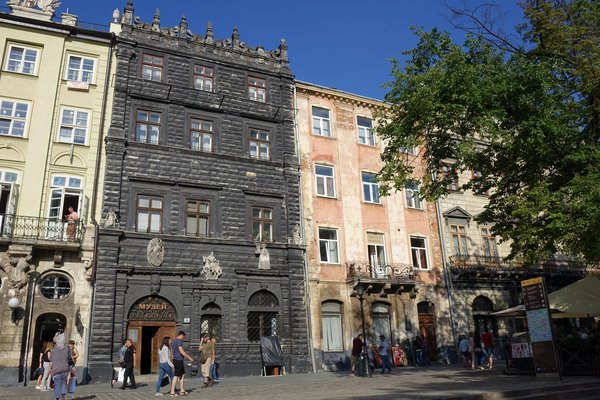Ukraine
L'viv
L'viv - the Ensemble of the Historic Centre represents a late medieval crossing point of cultures and architectural traditions.
The trade routes in the Middle Ages attracted a number of ethnic groups with different traditions: Ukrainian, Armenian, German, Jewish, Polish, Italian and Austrian. These groups lived in separate yet interdependent communities, and left their own religious and artistic marks on its historic centre and in St. Yuri’s Cathedral.
Community Perspective: L’viv is worth visiting for its lively atmosphere alone. Among its highlights are the Armenian Cathedral, the Boim Chapel and the merchants’ houses at Rysnok Square.
Site Info
Official Information
- Full Name
- L'viv - the Ensemble of the Historic Centre (ID: 865)
- Country
- Ukraine
- Status
-
Inscribed 1998
Site history
History of L'viv
- 2023: In Danger
- "as a result of the war in Ukraine, optimal conditions are no longer met to fully guarantee the protection of the OUV"
- 1998: Inscribed
- Inscribed
- In Danger
- "as a result of the war in Ukraine, optimal conditions are no longer met to fully guarantee the protection of the OUV" Since 2023
- Type
- Cultural
- Criteria
- ii
- v
Links
- UNESCO
- whc.unesco.org
- Official
-
- lviv.travel — Official Travel Site
- Related
-
- museum.lviv.ua — Historical Museum (in Ukrainan)
- en.wikipedia.org — L'viv on Wikipedia
All Links
UNESCO.org
- whc.unesco.org — whc.unesco.org/
Official Website
- lviv.travel — Official Travel Site
Related Resources
- museum.lviv.ua — Historical Museum (in Ukrainan)
- en.wikipedia.org — L'viv on Wikipedia
News Article
- March 8, 2022 france24.com — Statues wrapped in foam and fireproof material can be seen all around the historic city of Lviv, where the race is on to protect cultural treasures against possible Russian bombardment.
- Sept. 7, 2011 jta.org — The Ukraine government has begun the allegedly illegal demolition of a 16th century synagogue in Lviv to build a hotel
- April 12, 2011 interfax.com.ua — All historical monuments in Lviv should comply with UNESCO standards by Euro 2012
Community Information
- Community Category
- Urban landscape: Urban continuity
Travel Information
Red Zone Travel Advisory
Recent Connections
-
Perfect Inscriptions
1998 -
Red Zone Travel Advisory
Ukraine fully off-limits -
Creative Cities
LiteratureSee www.unesco.org
Connections of L'viv
- Trivia
-
-
On beer cans and bottles
LvivskeSee en.wikipedia.org
-
Depicted in Mizielinska Maps
Town hallSee i.pinimg.com
-
Dubbed as another WHS
Eastern Vienna, Florence of the East -
Built or owned by Poles
The Domenican Church was commissioned by Józef Potocki -
Built or owned by Germans
Boim Chapel was built by German architect Andreas Bemer -
On Banknotes
Lviv Theatre of Opera and Ballet on 20 hryvnia 2016 series
-
- History
-
-
Second World War
Lviv pogroms (1941): consecutive massacres of Jews in June and July 1941. The massacres were perpetrated by Ukrainian nationalists (specifically, the OUN), German death squads, and local crowds from 30 June to 2 July, and from 25 to 29 July, during the German invasion of the Soviet Union. Thousands of Jews were killed. In 2016, a memorial was erected commemorating the victims of the pogrom on the site of the former Golden Rose Synagogue.See en.wikipedia.org
-
Tatars
invaded 1589 -
Fusion
outstanding example of the fusion of the architectural and artistic traditions of eastern Europe with those of Italy and Germany (AB ev) -
Habsburgs (Austrian)
Theatre of Opera and Ballet among others
-
- Architecture
-
-
Rococo
St George Cathedral -
Mannerism
Bernardine Church: In the 17th century the present day church and monastery were constructed .. in the style of Italian and Dutch mannerism and consecrated in 1630. (wiki) -
Mosaic art
Armenian Cathedral -
Baroque
Dominican Church -
Renaissance
Boim Chapel
-
- World Heritage Process
-
-
Perfect Inscriptions
1998
-
- Religion and Belief
-
-
Jesuit Order
The St. Peter and Paul Church of the Jesuit Order [Kostiol Jezuitiv] -
Karaites
Some Karaites lived in Lvov, in "Red Russia" (or eastern Galicia). Their quarter was, till 1457, outside of the city walls. They had a synagogue of their own, but shared the cemetery with the Rabbanites -
Armenian Orthodox Church
Armenian church -
Cathedrals
Armenian Catholic Cathedral, Latin Cathedral and probably St. George's Cathedral -
Dominican Order
Dominican Church -
Museums of Atheism
The Dominican Church: After World War II the complex was occupied by the Soviets, used as warehouse and in the 1970s changed into a museum of religion and atheism. With the collapse of the Soviet Union the church was given to the Ukrainian Greek Catholic Church and now serves as a parish church. The monastery, however, has not yet been returned and still serves as a museum (renamed The Lviv Museum of History of Religion). (Wiki) -
Eastern Catholic Churches
Ukrainian Catholic, Armenian Catholic -
Jewish religion and culture
Ruins of the synagogue at the city walls
-
- Human Activity
- Constructions
-
-
Equestrian Statues
Dasnilo Galitsky Halyts'ka Sq. "Daniel of Galicia", King of Rus and founder of L'viv. Credited with developing western contacts in 13th C whilst the area was still under Mongol suzerainty -
Freestanding Bell Tower
Assumption Church -
Historic Pharmacies
The Pharmacy Museum "Under the Black Eagle" (1735) -
Large squares
Market Square, 18000 m2
-
- WHS on Other Lists
-
-
U.S. Ambassadors Fund
Documentation of the Site of the 16th-Century Turei Zahav (Golden Rose) Synagogue and Associated Buildings (2009), Conservation and Display of 16th-19th-Century Icons in the Studion Icon Collection (2008), Conservation of a 12th-Century Manuscript and Its Marginalia in the Collection of the Lviv History Museum (2007), Conservation of the 16thâ€Century Alberti ("Black") House on Rynok Square in L'viv -
Creative Cities
LiteratureSee www.unesco.org
-
- Timeline
-
-
Built in the 13th century
"It gradually developed by the 13th century into an organized and well fortified town", and the oldest remaining church (Church of St Mykolai) is also 13th century. Many of the other structures were reconstructed, or rebuilt in a new style between the 16th and 19th centuries
-
- Visiting conditions
-
-
Red Zone Travel Advisory
Ukraine fully off-limits
-
- WHS Names
-
-
Named after individual people
Leo the great
-
News
- france24.com 03/08/2022
- Statues wrapped in foam and firepr…
- jta.org 09/07/2011
- The Ukraine government has begun t…
- interfax.com.ua 04/12/2011
- All historical monuments in Lviv s…
Recent Visitors
Visitors of L'viv
- Adrian Turtschi
- Alexander Barabanov
- Alexander Lehmann
- Ali Zingstra
- Alvaro1404
- Ammon Watkins
- Ana
- Anna Wludarska
- Artur Anuszewski
- Aspasia
- Assif
- Atila Ege
- BaziFettehenne
- Bill Maurmann
- Bin
- Carlos Sotelo
- Cezar Grozavu
- chenboada
- ChrisDorn
- ChrisN
- Christer Sundberg
- Christian Wagner
- Cirene Moraes
- Corinne Vail
- Csaba Nováczky
- CugelVance
- czesioszpachelka
- Dagmara
- Daniel Gabi
- Danieljbromberg
- Danny L
- Dan Pettigrew
- del
- Dimitar Krastev
- Dirk-pieter
- Dolemite92
- Dorejd
- Els Slots
- Erik G
- Erik Jelinek
- Evgenii
- Fan Yibo
- Feldhase
- Filip Murlak
- finsbury_jo
- Gabor
- g.emma_bae
- George Gdanski
- Harald T.
- Harry Mitsidis
- H Beswick
- Iain Jackson
- Ian Cade
- Ilya Burlak
- Ivan Rucek
- Jakubmarin
- Janos
- Jarek Pokrzywnicki
- Jezza
- Jonas Kremer
- jonathanfr
- Jon Opol
- Juha Sjoeblom
- KarenBMoore
- Kasper
- Ken DJ
- KentishTownRocks
- Kevin247
- Kevin Padley-Knight
- kjluebke
- Klara Woodson
- Knut
- Krijn
- krtek
- Krzysztof B
- Lado Joel
- Ligocsicnarf
- Loic Pedras
- Luis Filipe Gaspar
- Lukasz Palczewski
- Maciej Gil
- Malgorzata Kopczynska
- Małgosia Łupicka
- marcel staron
- MarcoB_0
- Marcobrey
- Martin
- Martina Rúčková
- Mateusz
- Michael Ayers
- Michael Novins
- Mikko
- Milan Jirasek
- Miloš Tašković
- miri2808
- MMM
- nan
- NH1984
- Nick M
- nicku
- Nihal Ege
- palka25
- Pieter Dijkshoorn
- Piotr Wasil
- Rafał Kałczuga
- Rahelka
- Reza
- RobRos
- Roger Ourset
- Roman Raab
- serghei.belous
- Sergio Arjona
- Simonf
- Solivagant
- Stanislaw Warwas
- Stijn
- Szabolcs Mosonyi
- Szucs Tamas
- Tetena
- Tevity
- Thomas Buechler
- Timothy C Easton
- Tony H.
- triath
- Tsunami
- Van Hung
- Vernon Prieto
- Wojciech Fedoruk
- Wo_ko
- Xiquinho Silva
- YaroMir
- Yevhen Ivanovych
- Złoty Tłok Czesław
- Zoë Sheng
Community Reviews
Show full reviews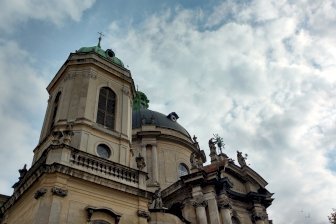
While I write this, the Russian army is bombing and shelling Ukraine, targeting and killing civilians indiscriminately. Whole towns are obliterated and millions of Ukrainians are fleeing the front lines. So far, L'viv being the western most major city of Ukraine has been spared the worst, but individual bomb raids have reached it. Hopefully, the precious jewel that is L'viv will remain unscathed, while the Ukrainians repel the Russian army.
One justification for the war can be found in Putin's now infamous pseudo historic treatise on Ukraine. It's major claim is that there is no such thing as an Ukrainian nation. All Ukrainians are really Russians at heart; Russians who need to be bombed back into the nation they belong to.
The whole argument is bs. Nations are constructs, not natural or historic givens. By Putin's logic, Austrians and the German speaking Swiss should be German; they decidedly are not. Listen to me and Philipp discuss the abuse of the German language that is parkieren, or try to explain to me what a Paradeiser (?!) is, and you will understand. Parken und Tomate are the proper German words if you are wondering.
In 1870, when Germany unified under Prussian banners, some felt German, but most felt they were Hessians, Prussians, Bavarians, Frisian (my paternal ancestors), Polish, Danish and what not. The German nation had to be created not just by blood and iron as Bismarck succinctly put it; and there was way too much of …
Keep reading 0 comments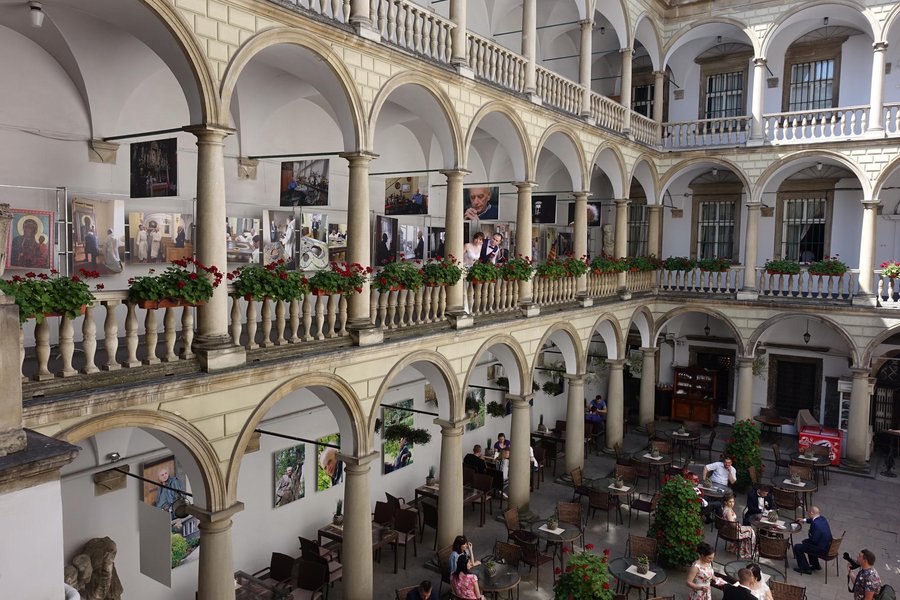
Lviv (Lvov, Lemberg) is a beautiful Central European city, but you shouldn't expect a grand majestic city like Prague, Budapest or Cracow. It is much more intimate in character. Its historic centre portrays medieval and Renaissance architecture, while its surroundings is mainly made of Neoclassical boulevards (prospects in Ukrainian) and churches (like the prominent St. George Cathedral). Some art nouveau architecture is present too (as for instance, the railway station) whereas Stalinist style buildings are surprisingly sparse.
In the centre there are numerous churches, the most special of which are, in my opinion, the Boim Chapel and the Armenian church. The Boim Chapel is an impressive family church, built in the 17th Century entirely of black stone and is artistically interesting.
The Armenian church is hidden in one of the smaller streets of the old town. Its entrance is hidden behind a barber shop. It has beautiful medieval frescoes and an atmospheric courtyard.
Look for the impressive sculptures of Pinsel, a local German artist of the 18th Century. His works are found in several churches and there is even a museum entirely dedicated to his oeuvre.
An important museum is the National Museum where you can admire the history of Ukrainian art. Its most important feature is its collection of historical icons.
Keep reading 0 comments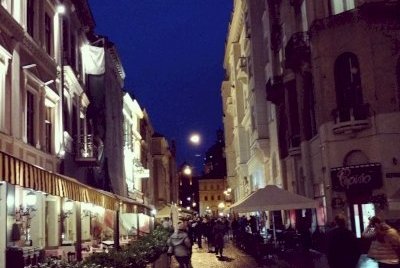
After the first partition of Poland in 1772, L'viv (Polish Lvov, German Lemberg) became part of Austrian Empire and was the capital of the region of Galicia. It would grow to be the 4th largest city of first the Austrian, then the Austrian-Hungarian Empire. Walking around it's old town today, you clearly see the Austrian influence in the architecture: It's feels like a small Vienna, quite out of place this far east.
While the Austrians, initially tried to Germanize the region, they never succeeded. Eventually, Polish became the administrative language spoken in the city by the Polish elite, while Ruthenian (Ukrainian) was the language of the countryside and the peasant population. It's a role reversal compared to cities further west where Polish was the peasant language while German the language of the city elite.
After the 2nd World War Stalin forcibly resettled the Polish (west) and Ukrainians (East) populations. The Polish replaced the Germans of Silesia that were expelled and had to migrate further west. This is why, if you are in Wroclaw (Breslau) you will find restaurants serving Lemberg/Lvov cuisine.
Wandering the streets of L'viv you feel like you can see a glimpse of the glory of the Austrian empire. This was a vibrant, cosmopolitan city, with Jews/Jiddish, Armenians, Polish, German, and Ukrainian influences. The Armenian church is a true gem as is eating at an authentic Jewish/Jiddish restaurant. It all ended due to World War 1.
L'viv rivals other central and eastern …
Keep reading 0 comments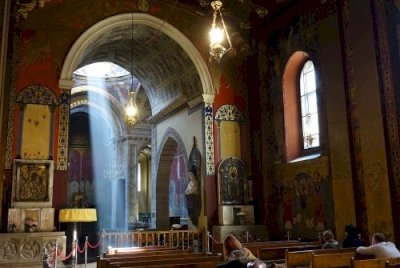
The Historic Centre of L’viv presents an eclectic mix of architectural and artistic highlights of both Eastern European and Western origin. I stayed there for 2 nights during the long Pentecost weekend. The city is very popular with Polish tourists – the border is only an hour away – and has a lively atmosphere with cafés, terraces and street performers. Cost levels are very low, they are comparable to those in Belarus which I visited last year and a fraction (25-30%) of those in Western Europe. It is easy to navigate in L’viv as signs around town are in English as well: a souvenir from the Euro 2012 football championships.
L'viv has traditionally been a trading city, and has been part of the Kingdom of Poland (until 1772) and Austria-Hungary (until 1918). It attracted different populations that lived in their own communities - from Armenians to Jews, and from Ukrainians to Germans and Hungarians. Reminders of this multicultural history can still be found, though most of them have only been revived since post-Soviet times. Much of the buildings that one sees nowadays around town date back to ca. 1900, and subsequently there is a lot of Art Nouveau.
The city has no exceptional highlights that would warrant a WH listing on its own and it lacks a certain prettiness that for example attracts the tourist masses to a town like Cesky Krumlov, but there is a bunch of sights that are worth seeing anyway. The Armenian Cathedral for …
Keep reading 0 comments
The Old Town in Lviv was named a Unesco World Heritage Site not without a reason. In the old city of Lviv different cultures reflect. Here the respective rulers - Poles, Austrians, Ukrainians - left their mark. The old town of Lviv is reminiscent of the old Austria or Krakow. However, it has not been renovated.
Everywhere there are places where one can feel transported into a bygone century. The center of the old town is the Rynok. Here is the Ratusha. The old town hall houses today the county government of Lviv region. You can climb the great tower of the building for a small fee (about 40 euro cents). Then you have a wonderful panoramic view of the entire old town. In the old town there are eight churches. The oldest of these is the Armenian Mary's Cathedral in the Krakivska road. It was built around 1356. And such a variety of galleries and museums... The Ukrainian National Museum boasts a large collection of icons. As for the old synagogue in the Staroevreiska road, unfortunately the foundation walls are only preserved. Another highlight of the Old Town is the old Opera Lviv.
Keep reading 0 comments
Our first visit to Lviv was fall of 2010....a very old city with rich history....We stayed in the city center and were blown away by the beautiful old buildings, monuments, churches. Parks. Needed some upgrading to be sure, but such a surprising "find". Subsequent visit in 2011 showed construction everywhere-streets, airport , downtown- in preparation for the Eurocup in'12 . Still very enjoyable to stroll, rest in coffee shops, visit museums. On this, our 3rd visit to Lviv , summer, 2013, we are amazed by the positive changes in the city..the new airport is stunning, and the old buildings downtown have been refurbished. So much to see and enjoy in this old city.....I predict a flood of visitors when word gets out on the quality of hotels, food, transportation and the best part, the people who are giving such good service ! Things have changed !!
Keep reading 0 comments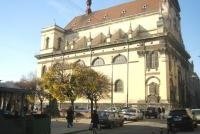
If you want to relax, eat good food and take long walks in a beautiful town with brilliant architecture, Lviv is the place for you. Though still quite expensive to reach, it's financially rewarding once you get there. A three-course meal in the best restaurant in town did not cost me more than 14 euros and the average price was far below that.
The Rynok Square is the centre point of the town and is in the old town and it is here you will find the true historic atmosphere. As a trading point between the east and the west, the rich town of Leopolis developed here already back in the 13th century. My personal prediction is that within 10 years from now, Lviv will be a serious destination on the tourist map of Europe. Just wait until Lviv has transformed from its current state of faded beauty and it will be a place well worth discovering for those looking for the absolute best pearls in Eastern Europe.
Keep reading 0 comments
